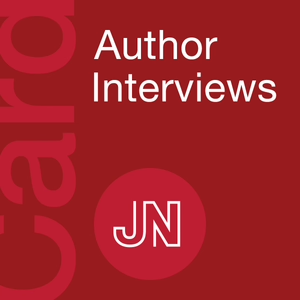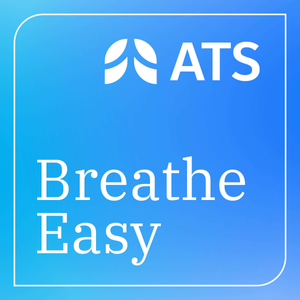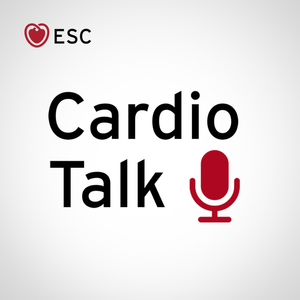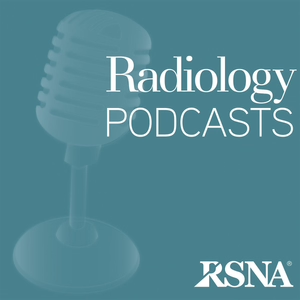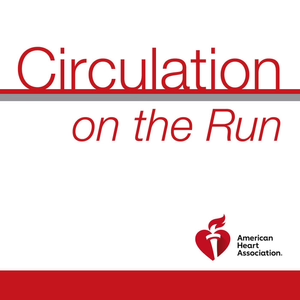
Circulation May 27, 2019 Issue
05/27/19 • 30 min
Dr Carolyn Lam: Welcome to Circulation on the Run, your weekly podcast summary and backstage pass to the journal and it's editors. We're your co-hosts, I'm Dr Carolyn Lam, associate editor from The National Heart Center and Duke National University of Singapore.
Dr Greg Hundley: And I'm Greg Hundley, associate editor for Circulation and director of The Pauley Heart Center at VCU Health in Richmond, Virginia.
Dr Carolyn Lam: Guess what Greg? Right after this we have a double feature discussion. It is all about dapagliflozin with some really, really important self-analyses from the DECLARED-TIMI 58 trial and about heart failure in Type 2 Diabetes with dapagliflozin. But, all of that coming right up only after we have our chat. So Greg, what do you have for us today?
Dr Greg Hundley: My first article is going to be from Dr Mintu Turakhia at the VA Palo Alto healthcare system at Stanford University and is going to discuss the practice variation in anticoagulation prescription and outcomes after device-detected atrial fibrillation. It's a study that has insights from the VA Health Administration. This study evaluated the relationship between oral anticoagulant prescription practice variation in response to new device detected atrial fibrillation and the association to outcomes.
As you know Carolyn, there are no clearly defined thresholds of AF burden, for which to initiate oral anticoagulation.
Dr Carolyn Lam: Interesting, so what did they find, how did they do this?
Dr Greg Hundley: Carolyn, the investigators performed a retrospective cohort analysis using data from the Veterans Health Administration linked to remote monitoring data that included day level AF burden. They included patients with cardiac implantable electronic devices and remote monitoring from the years 2011 through 2014. A CHA2DS2-VASc score of greater or equal to 2, and no prior stroke or oral anticoagulant receipt in the preceding 2 years. They determined the proportion of patients prescribed oral anticoagulants within 90 days following new device-detected AFib across a range of AFib thresholds. Greater than or equal to 6 minutes, all the way up to greater than 24 hours. And they examined sight variation in oral anticoagulation prescription.
Dr Carolyn Lam: And so? What did they find?
Dr Greg Hundley: Well, you ask among 10,212 patients with defibrillators, proportion receiving oral anticoagulation varied based on device detected AF burden. For example, for those greater than or equal to 6 minutes, it was roughly 13% of individuals, for those greater than 24 hours, 27% of individuals received oral anticoagulants. Importantly, there was a substantial sight variation in oral anticoagulation prescription after device-detected atrial fibrillation, for example, greater than one hour. The median was 16%, but it ranged from as low as 3% up to highs of 67%. And so, in adjusted models, oral anticoagulant prescription after device-detected AFib of greater than 24 hours was associated with reduced stroke risk and has a ratio of 0.28, p-value's 0.02, although, the propensity adjusted model was significant when AFib lasted at least 6 minutes.
So, in conclusion, among veterans with implanted devices, device-detected atrial fibrillation is common. There is large practice variation in 90-day oral anticoagulation initiation after new device-detected AFib with low rates of treatment overall, even for episodes greater than 24 hours. Remember, we said that rate was 27%. The strongest association of oral anti-coagulation with reduction in stroke was observed after device-detected Afib of greater than 24 hours. And what this study shows, is that randomized trials are needed to perform these observational findings.
So, Carolyn, how about your next study?
Dr Carolyn Lam: Well, from anti-coagulants to anti-hypertensives. I'm going to tell you about the 6-month results if the RADIANCE Hypertension Solo Trial.
Dr Greg Hundley: Oh, so, what was the RADIANCE Hypertension Solo Trial? Can you remind us?
Dr Carolyn Lam: Glad you asked. So the trial was the one that demonstrated a greater reduction in daytime ambulatory systolic blood pressure at 2 months by endovascular ultrasound renal denervation compared with a sham procedure among patients who were not treated with anti-hypertensive medications. So the current paper, led by Michel Azizi from Université Paris-Descartes and colleagues, now report the 6-month results following the addition of a recommended, standardized, stepped-care anti-hypertensive treatment to the randomized endovascular procedure under continued blinding to the initial treatment.
Now, remember these were patients with uncontrolled combined systolic and diastolic hypertension who were initially off medications for two months following randomization. Now, between two and five months, if the monthly measured home blood pressure was more than 135/...
Dr Carolyn Lam: Welcome to Circulation on the Run, your weekly podcast summary and backstage pass to the journal and it's editors. We're your co-hosts, I'm Dr Carolyn Lam, associate editor from The National Heart Center and Duke National University of Singapore.
Dr Greg Hundley: And I'm Greg Hundley, associate editor for Circulation and director of The Pauley Heart Center at VCU Health in Richmond, Virginia.
Dr Carolyn Lam: Guess what Greg? Right after this we have a double feature discussion. It is all about dapagliflozin with some really, really important self-analyses from the DECLARED-TIMI 58 trial and about heart failure in Type 2 Diabetes with dapagliflozin. But, all of that coming right up only after we have our chat. So Greg, what do you have for us today?
Dr Greg Hundley: My first article is going to be from Dr Mintu Turakhia at the VA Palo Alto healthcare system at Stanford University and is going to discuss the practice variation in anticoagulation prescription and outcomes after device-detected atrial fibrillation. It's a study that has insights from the VA Health Administration. This study evaluated the relationship between oral anticoagulant prescription practice variation in response to new device detected atrial fibrillation and the association to outcomes.
As you know Carolyn, there are no clearly defined thresholds of AF burden, for which to initiate oral anticoagulation.
Dr Carolyn Lam: Interesting, so what did they find, how did they do this?
Dr Greg Hundley: Carolyn, the investigators performed a retrospective cohort analysis using data from the Veterans Health Administration linked to remote monitoring data that included day level AF burden. They included patients with cardiac implantable electronic devices and remote monitoring from the years 2011 through 2014. A CHA2DS2-VASc score of greater or equal to 2, and no prior stroke or oral anticoagulant receipt in the preceding 2 years. They determined the proportion of patients prescribed oral anticoagulants within 90 days following new device-detected AFib across a range of AFib thresholds. Greater than or equal to 6 minutes, all the way up to greater than 24 hours. And they examined sight variation in oral anticoagulation prescription.
Dr Carolyn Lam: And so? What did they find?
Dr Greg Hundley: Well, you ask among 10,212 patients with defibrillators, proportion receiving oral anticoagulation varied based on device detected AF burden. For example, for those greater than or equal to 6 minutes, it was roughly 13% of individuals, for those greater than 24 hours, 27% of individuals received oral anticoagulants. Importantly, there was a substantial sight variation in oral anticoagulation prescription after device-detected atrial fibrillation, for example, greater than one hour. The median was 16%, but it ranged from as low as 3% up to highs of 67%. And so, in adjusted models, oral anticoagulant prescription after device-detected AFib of greater than 24 hours was associated with reduced stroke risk and has a ratio of 0.28, p-value's 0.02, although, the propensity adjusted model was significant when AFib lasted at least 6 minutes.
So, in conclusion, among veterans with implanted devices, device-detected atrial fibrillation is common. There is large practice variation in 90-day oral anticoagulation initiation after new device-detected AFib with low rates of treatment overall, even for episodes greater than 24 hours. Remember, we said that rate was 27%. The strongest association of oral anti-coagulation with reduction in stroke was observed after device-detected Afib of greater than 24 hours. And what this study shows, is that randomized trials are needed to perform these observational findings.
So, Carolyn, how about your next study?
Dr Carolyn Lam: Well, from anti-coagulants to anti-hypertensives. I'm going to tell you about the 6-month results if the RADIANCE Hypertension Solo Trial.
Dr Greg Hundley: Oh, so, what was the RADIANCE Hypertension Solo Trial? Can you remind us?
Dr Carolyn Lam: Glad you asked. So the trial was the one that demonstrated a greater reduction in daytime ambulatory systolic blood pressure at 2 months by endovascular ultrasound renal denervation compared with a sham procedure among patients who were not treated with anti-hypertensive medications. So the current paper, led by Michel Azizi from Université Paris-Descartes and colleagues, now report the 6-month results following the addition of a recommended, standardized, stepped-care anti-hypertensive treatment to the randomized endovascular procedure under continued blinding to the initial treatment.
Now, remember these were patients with uncontrolled combined systolic and diastolic hypertension who were initially off medications for two months following randomization. Now, between two and five months, if the monthly measured home blood pressure was more than 135/...
Previous Episode
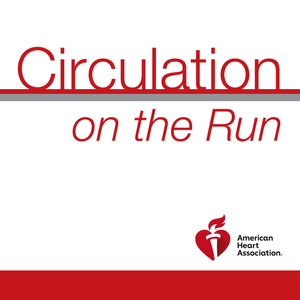
Circulation May 21, 2019 Issue
Dr Carolyn Lam: Welcome to Circulation on the Run, your weekly podcast summary and backstage pass to the journal and its editors. I'm Dr Carolyn Lam, Associate Editor from the National Heart Center and Duke National University of Singapore.
Dr Greg Hundley: And I'm Greg Hundley, Associate Editor of Circulation and Director of the Pauley Heart Center at VCU Health in Richmond, Virginia. Well, Carolyn, our feature article is going to focus on trastuzumab-induced cardiac dysfunction in breast cancer patients. We will discuss with Stanford investigators their use of pluripotent stem cells that are differentiated to cardiomyocytes and subsequently exposed to toxins to determine an individual's susceptibility to cardio-toxicity from cancer treatment. But before we get to that, Carolyn, do you have a paper that you'd like to discuss?
Dr Carolyn Lam: Well, the first paper deals with cardiac biomarkers and asks the questions, can these biomarkers be useful for the diagnosis and risk stratification of syncope?" Now, this paper is from Dr Mueller and colleagues from University of Hospital Basel in Switzerland. They evaluated the diagnostic and prognostic accuracy of BNP, NT-proBNP, high-sensitivity cardiac troponin T, and high-sensitivity cardiac troponin I concentrations, alone and against the ones of clinical assessments in more than 1,500 patients presented with syncope to the emergency department in a prospective, diagnostic multi-center study. Now, cardiac syncope was adjudicated in 234 or 15% of patients. What they found was that the diagnostic accuracy from cardiac syncope, as quantified by the area under curve, was 0.77 to 0.78 for all four biomarkers. That was superior to that of the syncope-specific diagnostic score, EGSYS.
Now, combining the four biomarkers further improved diagnostic accuracy to an area under curve of 0.81. Furthermore, using the four biomarkers at cutoffs achieved predefined thresholds for sensitivity and specificity and allowed rule-in or rule-out of 30% of all patients. Finally, the biomarkers predicted adverse cardiac outcomes with moderate to good prognostic accuracy and better than some of the existing syncope risk-prediction scores.
Dr Greg Hundley: Very interesting, Carolyn. Do you think we can now use this clinically? Should we be drawing these biomarkers on patients with syncope?
Dr Carolyn Lam: These results really do imply that these biomarkers look like useful tools for the early rule-out and/or rule-in of cardiac syncope in the emergency department. After all, these biomarkers are readily available, inexpensive, and results of this study suggest that they have potential to simplify diagnosis and to risk stratify in challenging presentations. However, before embracing the concept of ordering cardiac biomarkers routinely for syncope presentation, we really need to read the editorial by Dr Sandhu and Sheldon, in which important perspectives are presented, such as considerations of the certainty of the diagnosis of syncope, the usefulness of the comparative scores, the timing of testing, the potential unintended adverse consequences of testing. These editorialists concluded that, although promising, further work is needed to determine how the use of cardiac biomarkers should be incorporated into a risk-stratification algorithm.
Dr Greg Hundley: Wow, Carolyn. It sounds like we'd get a lot out of that particular editorial. I'm going to switch over and talk about NT-proBNP in patients with pulmonary hypertension. This is a paper from Dr Kelly Chin from UT Southwestern, and the study evaluated the utility of end terminal pro BNP level thresholds and assessing prognosis in pulmonary hypotension using the GRIPHON study. So GRIPHON is a global double blind, randomized placebo control event driven phase 3 study which assesses the safety and efficacy or a Prostacyclin agonist that promotes pulmonary arterial vasodilation.
They performed the study in patients that were 18 to 75 years old with a diagnosis of idiopathic pulmonary hypertension, heritable hypertension or pulmonary hypertension associated with connective tissue disease, repaired congenital systemic pulmonary shunts, HIV infection, drug use or toxin exposure; and the diagnosis of pulmonary hypertension was confirmed by right heart catheterization and by a reduced 6-minute walk distance of 50 to 450 meters.
Eligible patients were permitted to take their other therapies including Endothelin receptor agonists and phosphodiesterase type-5 inhibitors. The patients were categorized into low, medium and high in terminal BNP level subgroups according to two thresholds. First, by just the tertiles within the study overall and the secondly by the ESC guideline cutoff ranges.
Dr Carolyn Lam: Nice, so what did they find Greg?
Dr Greg Hundley: Well first of all both thresholds either the tertile one of the ESC in follow-up NT-proBNP categories were highly progno...
Next Episode

Circulation June 04, 2019 Issue
Dr Carolyn Lam: Welcome to Circulation on the Run, your weekly podcast summary and backstage pass to the journal and its editors. We're your co-hosts. I'm Dr Carolyn Lam, Associate Editor from the National Heart Center and Duke National University of Singapore.
Dr Greg Hundley: I'm Greg Hundley, Associate Editor for Circulation and Director of the Pauley Heart Center in Richmond, Virginia at VCU Health.
Dr Carolyn Lam: So Greg, ever wondered if prophylactic use of ICDs would help prevent sudden cardiac death in dialysis patients? Well, guess what? We're going to be discussing it in the feature discussion of the ICD II trial coming right up. First, I hear you've got a very interesting probabilistic paper.
Dr Greg Hundley: Yes. It's very sweet. This is from Renata Micha at Tusk University and it's examining the cost effectiveness of the US Food and Drug Administration added sugar labeling policy for improving diet and health. So Carolyn, in this study, investigators used a validated micro simulation US impact food policy model to estimate cardiovascular disease and type II diabetes mellitus cases averted, quality adjusted life years, policy costs, health care, informal care, and loss productivity in health related savings and cost effectiveness of two different policy scenarios.
First, the implementation of the US Food and Drug Administration added to your labeling policy or just the sugar label. And second, further accounting for corresponding industry reformulation the sugar label plus reformulation. The models used nationally represented demographic and dietary intake data from the national health and nutrition examinations survey and diseased data from the centers for disease control and preventive wonder data base and policy affects in diet disease effects from meta-analysis and policy and health related costs from established sources. Probabilistic sensitivity analysis accounted for model parameter uncertainties and population heterogeneity.
Dr Carolyn Lam: Sweet indeed, so tell us all about probabilistic analysis Greg.
Dr Greg Hundley: Okay Carolyn, so between 2018 and then forecasting out into the future, so this is probabilistic, in the year 2037. The sugar label would prevent 354,400 cardiovascular disease cases, and 599,300 diabetes mellitus cases, gain 727,000 quality adjusted life years, and save 31 Billion dollars in net health care costs. Or 61.9 Billion dollars in societal costs incorporating reduce loss productivity and informal care costs and similar findings were accomplished for the sugar label plus reformulation scenario, both scenarios were estimated with greater than 80% probability to be cost saving by the year 2023.
Thus, the results of this simulation exercises indicated that implementing the FDAs added sugar labeling policy could generate substantial health gains and cost savings for the US population particularly if the new label stimulates industry reformulation. The authors point out that the compliance date for updating the nutrition facts label including the added sugar perversion has been continuously delayed. And the authors believe, their findings highlight the need for timely implementation of this label so as to maximize health and economic gains.
An excellent editorial was written by Elizabeth Magnuson at Saint Luke's Mid America Heart Institute revealing the strengths of this work and explains some of the variants that could occur in the results based on assumptions that were used in the authors micro simulation model.
Dr Carolyn Lam: That is so interesting Greg, thanks. So from policy to guidelines and this time on cardiopulmonary resuscitation or CPR, now we know that an out of hospital cardiac arrest, chest compression only CPR has emerged as an alternative to the standard CPR where we use both chest compressions and rescue breathes. Since 2010, CPR guidelines recommend chest compression only CPR for both untrained bystanders and trained bystanders who are unwilling to preform rescue breaths.
The current study really aimed to describe the changes in the rate and type of CPR perform before the arrival of emergency medical services doing three consecutive guideline periods with gradual adoption of compression only CPR and this was in Sweden. Now these were authors led by Dr Hollenberg from The Center of Resuscitation Science, Karolinska Institute in Stockholm, Sweden and colleagues and basically, they study all bystander witness out of hospital cardiac arrest reported in the Swedish register for CPR from 2000 to 2017. They found that there was a six fold higher proportion of patients receiving compression only CPR and a concomitant almost double rate of CPR before emergency medical services arrival, and these changes occurred over time. Any type of CPR was associated with doubled survival rates in comparison with cases not receiving CPR, and this association was observed in all time period...
If you like this episode you’ll love
Episode Comments
Generate a badge
Get a badge for your website that links back to this episode
<a href="https://goodpods.com/podcasts/circulation-on-the-run-255644/circulation-may-27-2019-issue-29730558"> <img src="https://storage.googleapis.com/goodpods-images-bucket/badges/generic-badge-1.svg" alt="listen to circulation may 27, 2019 issue on goodpods" style="width: 225px" /> </a>
Copy

